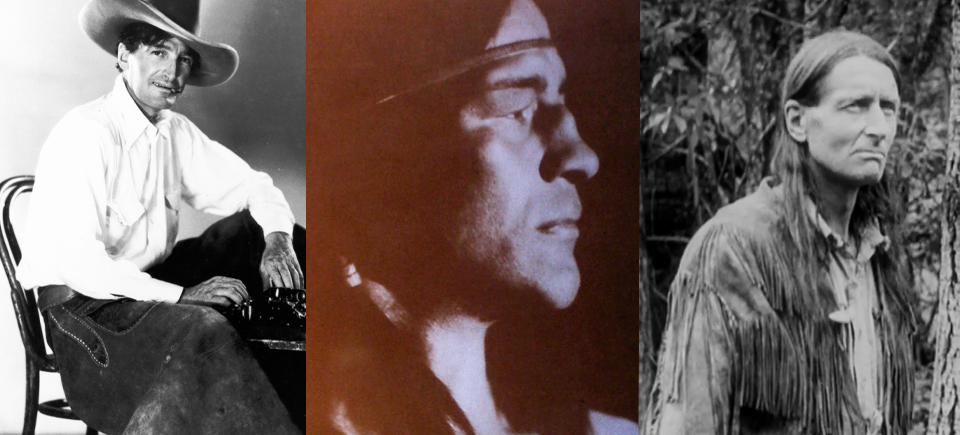
Imposters, Fakes and Charlatans
Imposters, Fakes and Charlatans
Do the names Ernest Dufault, Sylvester Long and Archibald Belaney mean anything to you? They should. All three were famous throughout the 20th century. All three achieved notoriety in their respective fields, and all three were big-time imposters.
In this day and age, it is next to impossible to pretend to be someone you are not. With the Internet and social media, the truth will come out quickly. In the early part of the last century, this was not the case. Imposters were able to pull off incredible lies without being discovered. Eventually these people were exposed, but it usually took many, many years.
Today I am proposing films on three fakes (imposters or charlatans, if you will) who rose to such incredible heights that it boggles the mind to think that they were not discovered sooner.
There was the story of Chief Buffalo Child Long Lance. Was he a black man? A white man? Or was he, as he claimed, a Blackfoot chief? The documentary Long Lance tells the incredible story of this imposter, from his humble beginnings in Winston-Salem, North Carolina, where he was born in the “coloured” part of town at the end of the 19th century, to his peak in Hollywood and New York. His real name was Sylvester Long, and although he had some Cherokee blood in him, he was seen by the people of his community as a “coloured” man, destined to be a second-class citizen the rest of his life.
The ever-ambitious Long joined a Wild West show at a young age and learned a little “circus Cherokee,” which helped him get into the Carlisle Indian School. The purpose of the school was to teach Aboriginals the “white” way of life and help eradicate their Indigenous roots. The irony here is obvious: pretend you are someone so that the authorities can strip you of that heritage.
Long moved around a great deal over the next few years, constantly reinventing himself. From part Cherokee, he then said he was full Cherokee, then part Blackfoot and then Blackfoot chief. Although he lied about his origins constantly, his real-life exploits were impressive. He fought at Vimy Ridge during World War I. He was a star reporter at The Calgary Herald. He became a movie actor and finally a world-renowned writer. He genuinely cared about the lives of Aboriginals in North America (especially his beloved Blackfoot) and wrote extensively on their plight. Throughout his life he tried to hide his origins, but eventually his past caught up with him. The movie below tells the incredible story of the man who would eventually be known as Chief Buffalo Child Long Lance. I guarantee you will be amazed at just how far he was able to take this charade.
Long Lance, Bernie Dichek, provided by the National Film Board of Canada
The story of Archibald Belaney is equally incredible. Born in Hastings, England, Belaney moved to Canada and eventually passed himself off as Ojibwe. In his youth he had been fascinated by the Native American way of life. When he settled in Canada, he took on a different persona and eventually became known as an environmentalist, working with what is now Parks Canada. He was also an author, writing about his experiences in nature. As with Sylvester Long, his past also caught up with him, and he would come to be known as one of the world’s greatest imposters. The two films I’ve included below were shot by Parks Canada in 1928 and 1929, showing Grey Owl (the name he chose for himself) and his wife with their beaver friends. (Please note that both these films are silent.)
Beaver People, , provided by the National Film Board of Canada
Beaver Family, , provided by the National Film Board of Canada
The story of Ernest Dufault is similar to Belaney’s, except that Dufault came from a small town in Quebec and became known to the world as Will James, writer and illustrator of Western stories. Not bad for a man who grew up speaking French only. He learned English when he moved to southern Saskatchewan to give the cowboy way of life a try. He had been fascinated with the Wild West in his childhood. He went to California after his stint on the Prairies and made his living drawing scenes of cowboy life. He invented his cowboy persona, Will James, a name that to this day is synonymous with life in the West. He wrote several famous Western stories, including “Smoky the Cowhorse,” that were turned into popular motion pictures. He eventually settled on a ranch in Montana, where his world began to crumble. Terrified of people discovering his past, he began to drink heavily and eventually succumbed to alcoholism. The film Alias Will James tells his story and includes an interview with country singer Ian Tyson, who talks about the debt he owes to James in helping him fall in love with the West. James’ family in Quebec is also featured. Many of them never knew how famous he had become.
Alias Will James, Jacques Godbout, provided by the National Film Board of Canada
These three imposters have left an incredible legacy. It is wrong to say that their actions only had negative consequences. Grey Owl’s conservation work definitely had a positive side. Will James’ stories have inspired and entertained countless generations, and Long Lance’s stories put the focus on the plight of Indigenous people in North America when no one knew or cared about their lives.
Three almost unbelievable life stories of men who dared to be someone they were not. What they did was certainly not right, but their stories are unforgettable.
Enjoy the films.



